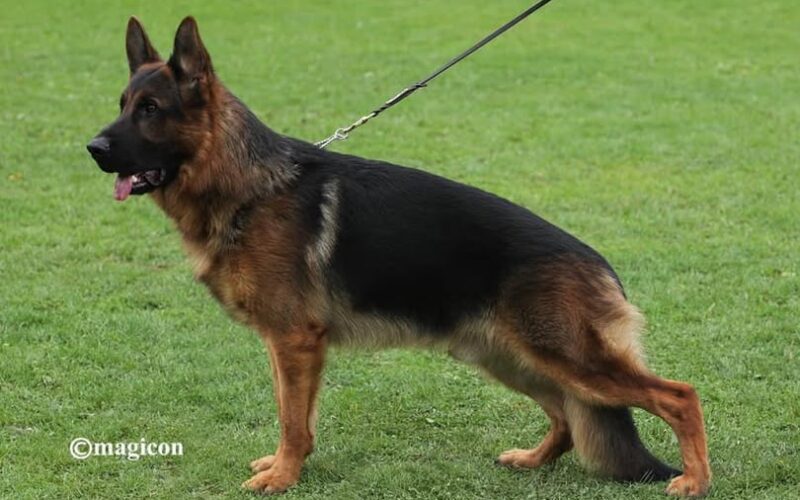The debate about the back structure of the German Shepherd Dog (GSD) has been ongoing for decades. Enthusiasts, breeders, and dog lovers constantly argue over terms like slant back and straight back, often leading to misconceptions about what the breed standard truly demands.
But what do these terms actually mean? Is there really such a thing as a slant back German Shepherd breed? And how much does the back structure affect a German Shepherd’s health, movement, and purpose?
This article breaks it all down — separating fact from fiction — and clarifying what every German Shepherd lover should know.
What Does the German Shepherd Breed Standard Say?
The official German Shepherd breed standard, originally set by the SV (Verein für Deutsche Schäferhunde) in Germany, clearly states that the breed should have a “strong back” and a smooth connection to the croup (the area leading to the tail).
This means the back shouldn’t be excessively curved, hunched, or weak. Instead, it should reflect the muscular strength and skeletal integrity that allows the GSD to perform the tasks it was bred for — herding, guarding, and working.
Important Point: The standard never uses the term slant back. The only reference to the dog’s outline is the sloping croup, which naturally gives the German Shepherd a slightly angled appearance.
Slant Back vs Straight Back: Where Did These Terms Come From?
The terms slant back and straight back aren’t official classifications in the German Shepherd breed. They were created by enthusiasts and sellers to describe what they perceived as two different “types” of GSD:
- Slant Back GSD – Refers to German Shepherds seen in dog shows, with a noticeable slope from shoulders to hips.
- Straight Back GSD – Often used to describe working-line German Shepherds, whose backs look more level.
However, these terms are informal and can sometimes be used as sales gimmicks to charge more for dogs or create artificial “categories.”
In reality, there is only one German Shepherd breed — but there are different lines:
- Show Line GSDs (often from Europe) tend to have a more sloped topline.
- Working Line GSDs tend to have a straighter, more utilitarian structure.
Does Stacking Make a German Shepherd Look More “Slanted”?
If you’ve seen pictures of show German Shepherds with dramatically sloped backs, it’s worth noting that posing (stacking) plays a huge role.
In dog shows, handlers often position the dog’s hind legs in a stacked stance — one leg extended back, the other slightly forward. This makes the croup slope look more dramatic in photos.
Reality Check: When these same dogs stand naturally, the back doesn’t look nearly as extreme.
The Problem with Over-Angulation
While a slight slope is part of the breed’s natural design, excessive angulation (overly sloped hindquarters) has been seen in some show lines, especially in the U.S.
This can lead to:
- Weakened movement (the dog may “wobble” or look unstable)
- Joint stress and potential hip issues
- Deviations from the breed standard
Even the GSD Federation of South Africa addressed this in their MAX Magazine (May 2005), emphasizing that extreme slopes are not correct and can compromise the breed’s functionality.
Straight Back German Shepherds: Working Lines Explained
Many people refer to working-line German Shepherds as “straight backs.” These dogs were bred more for utility than for show appearance.
They have:
- A slightly straighter topline (less obvious slope)
- Stockier, more athletic builds
- High endurance and drive
These dogs are often used by police, military, and search-and-rescue teams, where structure and stamina matter more than looks.
Are There Really Two Types of German Shepherds?
No. There’s only one official German Shepherd Dog breed, but different breeding goals created different lines:
- Show Lines – Bred for appearance according to show standards (sometimes resulting in a more sloped look).
- Working Lines – Bred for functionality and performance, usually with a straighter back.
Important: Calling them “slant back” or “straight back” creates misleading categories. The correct terms are Show Line and Working Line.
Why Does the Back Structure Matter So Much?
The back structure impacts:
- Movement – A German Shepherd should move fluidly, like it’s “floating” when trotting.
- Endurance – Dogs with correct backs can herd, run, and work all day without strain.
- Health – Over-angulated dogs are more prone to hip and joint issues.
In other words, the back isn’t just about looks — it’s about the dog’s ability to do its job.
Key Takeaways on Slant Back vs Straight Back German Shepherds
- Slant back and straight back are not official terms — they’re nicknames used by enthusiasts and sellers.
- The official breed standard calls for a strong, straight back with a slight slope at the croup.
- Over-angulation (excessive slope) is a problem and can affect health and movement.
- The real distinction is between Show Line (slightly more slope) and Working Line (straighter back) GSDs.
Show Line vs Working Line German Shepherd: Key Differences
| Trait | Show Line German Shepherd | Working Line German Shepherd |
|---|---|---|
| Size | Slightly larger and heavier; bred for a more “majestic” look | Leaner, more athletic build for endurance and agility |
| Back Slope | Noticeable slope from shoulders to hips (more pronounced when “stacked” in shows) | Straighter topline with minimal slope |
| Color | Often rich black & red or black & tan; colors are bred for show standards | Typically darker — sable, bi-color, solid black, or dark shades |
| Temperament | Calm, balanced, suited for families and conformation shows | High drive, energetic, intense — suited for working roles (police, military) |
| Purpose | Bred mainly for appearance and dog shows | Bred for functionality, performance, and working tasks |
| Exercise Needs | Moderate; enjoys play and walks but less demanding | Very high; needs serious mental and physical stimulation daily |
| Availability | Easier to find through show breeders and kennels | Often sourced from specialized working dog breeders or K9 programs |
| Price Range | Can be more expensive due to pedigree and show titles | Prices vary, but working dogs with training can also be premium-priced |
Conclusion
The German Shepherd Dog remains one of the world’s most admired breeds, known for its loyalty, intelligence, and versatility.
While the terms slant back and straight back are often thrown around, they don’t define separate breeds. Instead, they reflect different breeding focuses — show versus work.
If you’re looking for a German Shepherd, focus less on whether it’s “slant” or “straight” and more on:
- The breeder’s ethics
- The dog’s health certifications
- What you want the dog for (work, sport, companionship, or show)
Because at the end of the day, whether slightly sloped or straighter, a well-bred German Shepherd will always be an iconic, capable, and beautiful dog.
👉 Would you like me to create a comparison table showing Show Line vs Working Line GSD traits (size, color, temperament, slope, purpose)?
👉 Or should I also add an FAQ section (e.g., Are slant back GSDs unhealthy? Which type is better for a family?) to boost SEO further?





